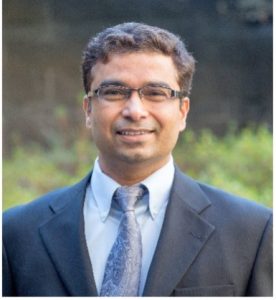Speaker: Dr. Ravi L. Hadimani, Associate Professor, Director, Biomagnetics Laboratory, Department of Mechanical and Nuclear Engineering, Virginia Commonwealth University
Title: Biomagnetic Materials for Diagnosing and Treating Cancer and Neurological Diseases
Abstract:
Magnetic nanoparticles have gained tremendous attention due to their ability to navigate through the body and vary the physical properties of the tissues of interest. Several researchers have demonstrated biomedical applications of Fe3O4 particles in hyperthermia, targeted drug delivery, and as contrast agents in magnetic resonance imaging (MRI). Elemental gadolinium has a transition temperature below the room temperature and is paramagnetic at room temperature; hence it is used as a T1 contrast agent. Gadolinium has one of the highest magnetic moments per atom (5th highest) and has one of the lowest magnetocrystalline anisotropy among the rare-earths, making it a soft rare-earth ferromagnetic material close to room temperature. Because of these unique properties, gadolinium has many potential biomedical applications. We have designed a novel technique to produce Gd5Si4 NPs that are soft ferromagnetic above the 300K. Our results of T2 measurements using a 7T MRI system show a significant reduction in relaxation time. However, longer milling times used in producing Gd5Si4NPs were found to reduce the magnetization and transition temperature; hence, we have developed a time–sensitive magnetic field–assisted size separation method. Using the size separation technique, we can tune the transition temperature of the magnetic nanoparticles that can be used as self-regulating hyperthermia agents and for MRI–guided thermometry.
Diagnosable neurological disorders afflict one in five Americans above the age of 18. Therefore, there is a critical need to develop new, safe, non-invasive methods for treating brain disorders. Transcranial Magnetic Stimulation (TMS) has the potential to tune a specific neuronal circuitry, such as motor circuitry, by stimulating a focused area of the brain cortex non-invasively and safely, thus treating the symptoms of several neurological disorders originating from the cortex and deep brain structures. Current TMS coils either lack the focality or the depth of stimulation or both. Biomagnetics Laboratory at VCU has developed ultra-focal TMS coils and tested them on custom–built brain phantoms of human subjects. With the use of high permeability and high saturation magnetic materials as cores along with shielding materials, TMS coils can be designed to stimulate deeper structures. To stimulate deeper structure and with high focality, it is not possible to use just the external coils. We are working on using extremely high permeability nanoparticles as flux concentrators in the brain to achieve high focality in deep brain stimulation.
In addition to working on the diagnosis and treatment of cancer and neurological diseases, we are working on using rare-earth magnetic nanoparticles composite materials for shielding high energy 5G/6G and Next G electromagnetic waves, magnetic cooling applications, and energy harvesting materials.
Biography: Dr. Hadimani is an Associate Professor and the Director of Biomagnetics Laboratory at the Department of Mechanical and Nuclear Engineering of Virginia Commonwealth University. He has founded the IEEE Joint Magnetics and Engineering in Medicine and Biology Society’s Richmond Chapter and he is the current vice chair of the chapter. He is an Associate Editor of journals, Frontiers of Neuroscience and American Institute of Physics (AIP) Advances.
Dr. Hadimani has a ‘first class’ honors degree in Mechanical Engineering from Kuvempu University, India, MS in Mechatronics from the University of Newcastle, UK and PhD in Electrical Engineering from Cardiff University, UK. He has served as a Project Scientist at the Institute of Materials Research and Innovation of the University of Bolton, UK. He was an Adjunct Assistant Professor and Associate Scientist at Iowa State University and was also an Associate of Ames Laboratory, US Dept. of Energy.
Dr. Hadimani’s research focus is on biomagnetic materials and devices for biomedical applications, magnetocaloric refrigeration and energy harvesting. He has developed a hybrid piezoelectric and photovoltaic energy harvester which is capable of harvesting electrical energy from solar, wind and rain energy. This invention was awarded the UK Energy Innovation Award in 2011. Dr. Hadimani is alsoawarded the International Young Scientist Fellowship by National Natural Science Foundation of China (NSFC) in 2013. He has received Engineer of the Year award by Richmond Joint Engineers’ Council in 2021. He has authored more than 95 peer-reviewed original research papers, more than 200 international conference papers, 10 current and pending patents, several invited trade magazine articles, a book and 3 book chapters to date.
Seminar Host:
Webinar Link:
